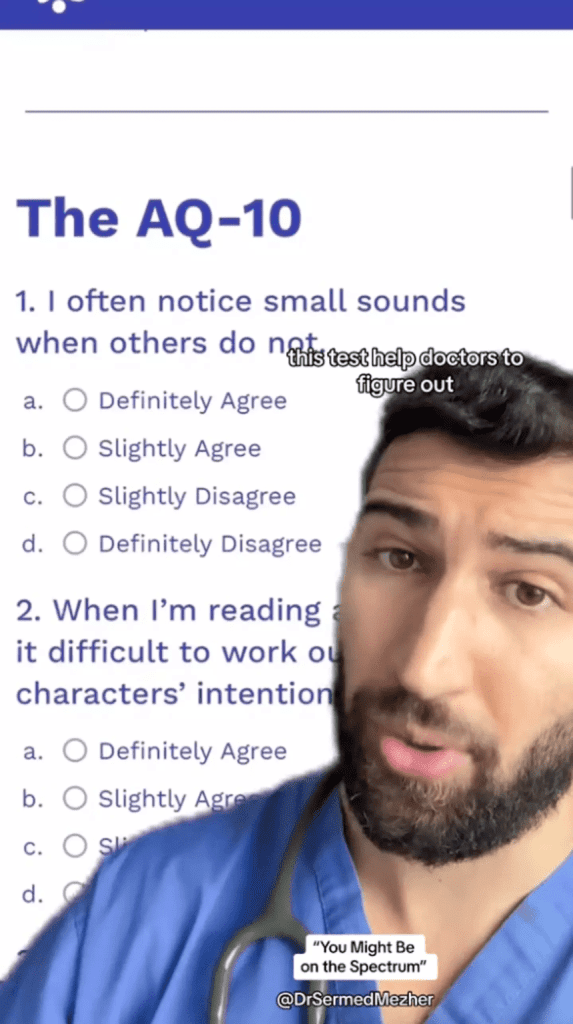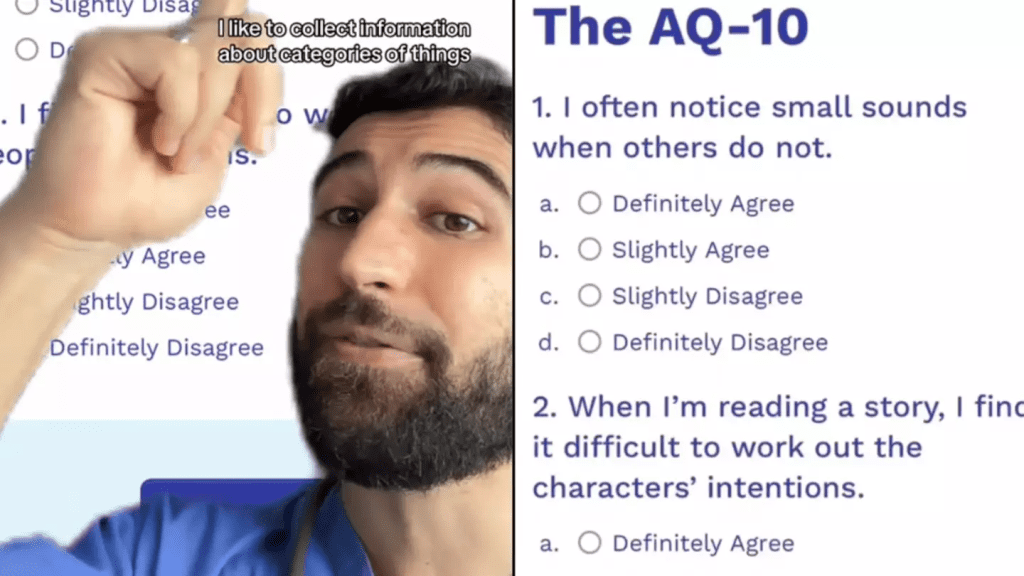Autism Spectrum Disorder (ASD) is a complex and varied neurological condition affecting individuals in unique ways. Recently, Dr. Sermed Mezher, a London-based doctor, shared a helpful tool on TikTok to guide people in recognizing possible signs of autism. The screening, known as the Autism Spectrum Quotient-10 (AQ-10), consists of ten questions that provide preliminary insights into autistic traits. While it’s not a diagnostic tool, this brief test can help identify signs that may suggest the need for a more comprehensive evaluation. Here’s what you should know about the AQ-10 and the top questions it includes.

Understanding Autism Spectrum Disorder (ASD)
ASD is often misunderstood, with many believing it to be an illness. However, as the NHS clarifies, autism simply means that a person’s brain works differently than others. Autism is a spectrum, meaning symptoms and characteristics vary widely from person to person. Some common traits include difficulties with social interactions, repetitive behaviors, and different ways of processing information. Recognizing these traits early can be essential, especially for accessing support and resources tailored to individual needs.
The AQ-10 provides an accessible first step for those wondering if they might have signs of autism, especially adults who may not have been screened earlier in life.
What is the AQ-10 Screening Tool?
Dr. Mezher describes the AQ-10 as a “brief screening tool designed to identify signs that may suggest a person could have autism.” This screening test consists of ten questions focusing on social communication, behavior, and sensory processing. Each question offers insight into potential autistic traits, though Dr. Mezher emphasizes that this test alone cannot confirm autism.
“A high score on the AQ-10 suggests that further assessment might be necessary, but it cannot confirm an autism diagnosis,” he explains. Instead, it helps indicate whether someone might benefit from a more comprehensive evaluation with a specialist.
The Top 10 AQ-10 Questions to Determine Potential Signs of Autism
Below are the 10 questions in the AQ-10, each of which corresponds to a specific trait often associated with autism. A point system is used based on your agreement or disagreement with each statement:
- I often notice small sounds when others do not.
If you agree, score one point.
Many individuals on the autism spectrum report heightened sensitivity to sounds, noticing subtle background noises that others may overlook. - When I’m reading a story, I find it difficult to work out the character’s intentions.
If you agree, score one point.
Understanding others’ perspectives and intentions can be challenging for some autistic people, especially in complex social situations. - I find it easy to read between the lines when someone is talking to me.
If you disagree, score one point.
For many on the spectrum, interpreting implied meanings or sarcasm is difficult, as they often take language literally. - I usually concentrate more on the whole picture, rather than the small details.
If you disagree, score one point.
Those with autism may have a more detail-oriented focus, often picking up on small details that others might miss. - I know how to tell if someone listening to me is getting bored.
If you disagree, score one point.
Reading social cues, like gauging if someone is engaged in conversation, can be challenging for many autistic people. - I find it easy to do more than one thing at once.
If you disagree, score one point.
Many individuals with autism may struggle with multitasking, as they prefer focusing deeply on one task at a time. - I find it easy to work out what someone is thinking or feeling just by looking at their face.
If you disagree, score one point.
Recognizing facial expressions and understanding emotions can be difficult, leading to challenges in social interactions. - If there’s an interruption, I can switch back to what I was doing very quickly.
If you disagree, score one point.
People on the autism spectrum often have a strong need for routine and may find disruptions more challenging to manage. - I like to collect information about categories of things.
If you agree, score one point.
Many autistic people have focused interests and enjoy categorizing information in specific areas of interest. - I find it difficult to work out people’s intentions.
If you agree, score one point.
Difficulty interpreting others’ motives and intentions is common in autism, adding complexity to social interactions.
How to Interpret the AQ-10 Results
The AQ-10 serves as an initial, informal step in understanding autistic traits. Dr. Mezher advises that a score of six or higher suggests a person may benefit from further assessment. However, it’s essential to remember that this screening tool is not definitive. Even if someone scores high on the AQ-10, only a trained professional can diagnose autism.
Dr. Mezher underscores that the AQ-10 is simply “a preliminary step to highlight whether a more comprehensive evaluation by a healthcare professional is warranted.” He encourages individuals to trust their instincts when answering the questions and to avoid overthinking responses. The aim is to capture a person’s natural tendencies rather than behaviors influenced by social expectations.
The Importance of a Professional Evaluation
If the AQ-10 suggests potential autistic traits, the next step is a formal evaluation. An official diagnosis of autism requires in-depth assessment, often involving:
- Clinical Interviews: These interviews allow specialists to understand how someone experiences social situations, sensory processing, and repetitive behaviors.
- Developmental History: Gathering information about childhood behaviors and experiences helps specialists detect early signs of autism that may have gone unnoticed.
- Observational Assessments: These may involve structured or unstructured observations of how someone responds in various scenarios.
A full assessment provides the depth needed to understand how someone’s unique traits fit within the autism spectrum and helps tailor support and resources accordingly.

Why Early Recognition Matters
Understanding autistic traits early on can make a significant difference in quality of life, especially for adults who may not have been screened as children. For many, recognizing autistic traits allows them to access tailored support, connect with communities, and embrace their unique strengths. Early recognition also provides a sense of validation, helping people understand why they might experience the world differently from others.
An autism diagnosis can be a valuable tool for understanding oneself better, fostering confidence in social settings, and even aiding career and educational planning. Dr. Mezher’s efforts to share accessible tools like the AQ-10 are valuable steps in promoting awareness and reducing stigma around autism.
Moving Beyond Labels: Embracing Neurodiversity
Autism is part of the broader concept of neurodiversity, which embraces variations in how people experience and interact with the world. For many, an autism diagnosis is not about “fixing” something but rather understanding one’s unique way of thinking and connecting with others. The NHS emphasizes that being autistic does not mean having an illness; rather, it signifies that one’s brain simply operates differently.
This perspective shifts the focus from “treatment” to support, self-acceptance, and building environments that respect individual needs. As awareness of neurodiversity grows, so does the importance of tools like the AQ-10, which help individuals identify with and understand their unique traits.
Conclusion: The AQ-10 as a First Step to Understanding Autism
The AQ-10, as shared by Dr. Sermed Mezher, provides a helpful and accessible first step for anyone questioning whether they might be on the autism spectrum. This brief screening tool focuses on key traits common among autistic individuals, offering a glimpse into possible signs of autism. However, it is only a preliminary measure—an invitation to seek further evaluation if needed.
As we learn more about autism and neurodiversity, tools like the AQ-10 remind us that understanding and acceptance are key. Whether someone seeks a diagnosis for clarity or support, the process can empower them to embrace their individuality and thrive in a world that values diverse perspectives.


